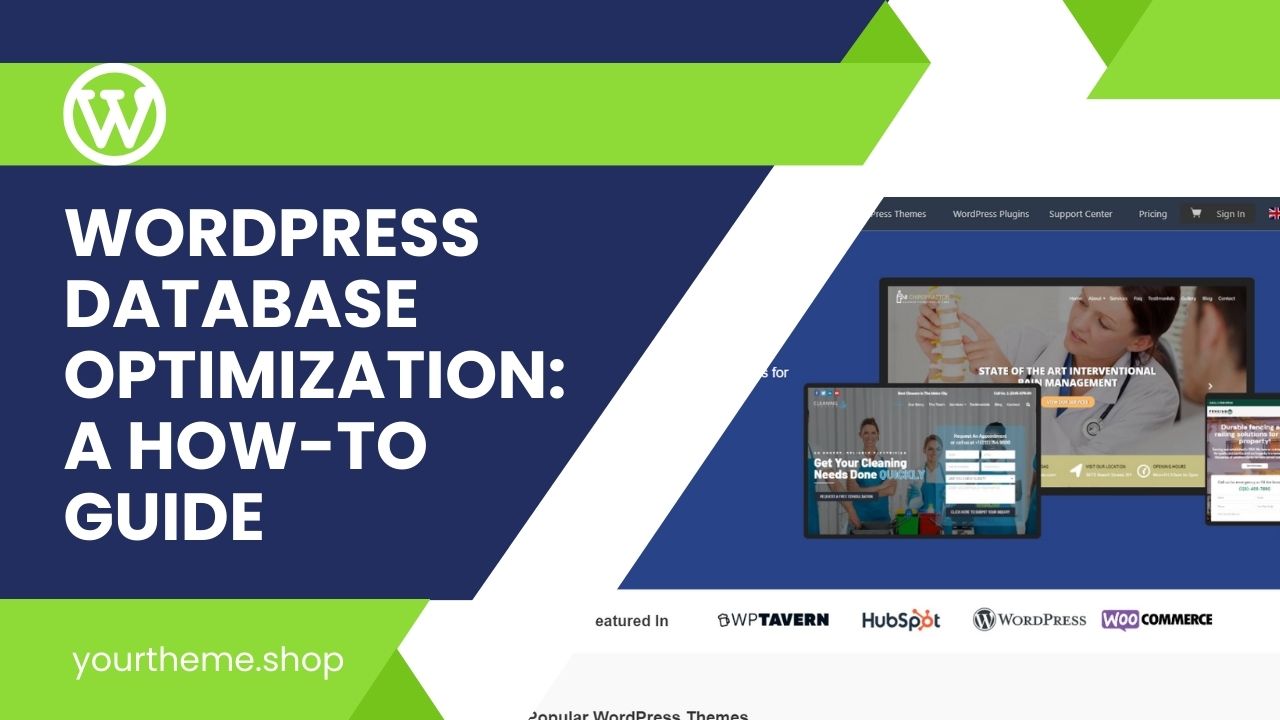WordPress database optimization is a crucial aspect of maintaining a high-performing website. As a guide to WordPress database optimization, it’s essential to understand the role of the database in WordPress. It stores all the vital information of your site, from posts and pages to settings and user data. Regular optimization ensures efficient data retrieval and storage, leading to improved website performance.
WordPress Database Optimization: A How-To Guide
Database Cleanup Plugins for WordPress Performance
To enhance WordPress performance, database cleanup plugins are invaluable. These plugins streamline the process of removing unnecessary data, such as spam comments, post revisions, and transient options. When choosing database cleanup plugins for WordPress performance, look for features like scheduled cleanups, easy-to-use interfaces, and compatibility with your WordPress version.
Step-by-Step Guide to WordPress Database Optimization
Pre-Optimization Backup
Before any optimization, ensure you have a complete backup of your WordPress database. This precaution safeguards your data against any accidental loss during the optimization process.
Detailed Optimization Process
Follow a systematic approach to WordPress database optimization:
- Clean up post revisions and drafts.
- Remove spam comments and unused tags.
- Optimize database tables.
- Limit post revisions and optimize autoloaded data.
Improving Website Speed with WordPress Database Optimization
A key component in improving website speed is WordPress database optimization. The database is where all your site’s critical data is stored and retrieved. When optimized, it significantly reduces the time required to fetch this data, leading to faster page load times, which is essential for user experience and SEO.
Regular Database Cleanups
Routine Cleaning for Performance Enhancement
Regularly cleaning your WordPress database is a fundamental step in WordPress database optimization: A How-To Guide. This involves removing unnecessary data like old revisions, spam comments, and transient options, which can bloat your database and slow down your website. Database cleanup plugins for WordPress performance can automate this process, ensuring your database remains lean and efficient.
Optimizing Table Indexes
Enhancing Data Retrieval Speed
Another crucial technique in improving website speed with WordPress database optimization is optimizing table indexes. Proper indexing ensures that the database can retrieve data as quickly as possible. This process involves analyzing your database tables and ensuring that indexes are properly used and maintained, which can be a complex task but is vital for database efficiency.
Minimizing Database Calls in Your WordPress Theme
Efficient Coding for Faster Performance
Minimizing database calls in your WordPress theme is an advanced strategy for improving website speed with WordPress database optimization. This involves optimizing your theme’s code to reduce the number of times it queries the database. Techniques include using WordPress caching plugins and optimizing your theme’s PHP code to make fewer, more efficient database queries.
Database Maintenance Best Practices for WordPress Sites
Ongoing Optimization for Sustained Performance
Adhering to database maintenance best practices for WordPress sites is essential for long-term website health. This includes regularly updating WordPress and its plugins, monitoring your database’s health, and using reliable hosting services. Regular maintenance ensures your database operates at peak efficiency, contributing significantly to overall website speed.
Advanced Techniques for Database Optimization
Leveraging Tools and Expertise for Optimal Performance
For those looking to delve deeper, advanced techniques in WordPress database optimization involve using tools like MySQL query optimizers and seeking expert advice. These methods can provide significant gains in performance, especially for larger, more complex websites
Database Maintenance Best Practices for WordPress Sites
Regular database maintenance is essential for the smooth running of your WordPress site. Establish a maintenance routine that includes regular backups, periodic cleanups, and database table optimization. Implementing these database maintenance best practices for WordPress sites ensures a streamlined and efficient database, contributing to overall site health.
Monitoring and Analyzing Database Performance
To maintain an optimized database, regularly monitor its performance. Use tools like phpMyAdmin or WordPress plugins to analyze database health. Look for slow queries and bottlenecks that might be affecting performance. Understanding and interpreting this data is key to ongoing WordPress database optimization.
Troubleshooting Common Database Issues in WordPress
Encountering database issues is common in WordPress. Identify problems like database connection errors, slow queries, or table corruption. Solutions range from optimizing specific queries to repairing corrupted tables. Preventative measures, such as regular backups and updates, are crucial.
Securing Your WordPress Database
Securing your WordPress database is a critical component of website maintenance. It’s not just about protecting data; it’s about safeguarding your site’s integrity and the trust of your users. A secure database underpins the overall security posture of your WordPress site.
Implementing Strong Access Controls
Creating Strong Usernames and Passwords
One of the foundational steps in securing your WordPress database is to use strong usernames and passwords. This simple measure is often overlooked, yet it’s crucial in protecting against brute-force attacks. Regularly updating these credentials adds an extra layer of security.
Limiting Database Access
Restricting database access is a key strategy in WordPress database optimization. Limit access to essential personnel only, and define user roles and permissions carefully. This approach minimizes the risk of accidental or malicious data alterations.
Regular Updates and Maintenance
Updating WordPress and Plugins
Keeping WordPress and its plugins up to date is vital in securing your WordPress database. Updates often include security patches that protect against known vulnerabilities. Incorporating this practice into your database maintenance best practices for WordPress sites is essential.
Regular Database Backups
Regular backups are a safety net for your WordPress database. In the event of a security breach or data loss, having a recent backup ensures you can restore your site quickly. This practice is a cornerstone of WordPress database optimization.
Advanced Security Measures
Implementing Database Security Plugins
Database cleanup plugins for WordPress performance often include security features. These plugins can help in optimizing and securing your database, providing functionalities like malware scanning and firewall protection.
Using Secure Connections
Secure connections are fundamental in WordPress database optimization. Utilizing SSL/TLS encryption is not just a security measure; it’s a vital component of improving website speed with WordPress database optimization. This section of the guide emphasizes the necessity of secure connections in safeguarding data during transmission.
Implementing SSL/TLS for Enhanced Performance
Steps to Enable SSL/TLS
- Purchase an SSL certificate or obtain a free one from services like Let’s Encrypt.
- Install and activate the SSL certificate on your hosting server.
- Configure WordPress to use HTTPS in settings and links.
Impact on Database Performance
Using SSL/TLS encryption can positively impact database performance. It ensures secure data transmission between the user and the server, which is a critical aspect of database cleanup plugins for WordPress performance.
Database Cleanup Plugins for WordPress Performance with Secure Connections
Selecting Plugins that Support SSL/TLS
When choosing database cleanup plugins for WordPress performance, prioritize those that are compatible with SSL/TLS encryption. This compatibility ensures that the data cleanup process is secure and efficient.
Enhancing Security During Database Cleanup
Best Practices for Secure Database Cleanup
- Regularly update your database cleanup plugins.
- Ensure that your cleanup activities are conducted over a secure connection.
- Backup your database before performing any cleanup operations.
Improving Website Speed with WordPress Database Optimization through Secure Connections
Role of SSL/TLS in Website Speed Optimization
The role of SSL/TLS in website speed optimization is pivotal. These encryption protocols not only bolster security but also contribute significantly to improving website speed. By securing data transfers between the server and the user’s device, SSL/TLS ensures that information is transmitted swiftly and securely.
SSL/TLS and SEO
Search engines consider SSL/TLS encryption as a ranking factor. Websites with SSL certificates tend to rank higher in search results. This dual benefit of security and SEO enhancement makes SSL/TLS an integral part of WordPress database optimization.
Implementing SSL/TLS for WordPress Database Optimization
Selecting the Right SSL Certificate
Begin by choosing the appropriate SSL certificate for your website. Options include single domain, multi-domain, and wildcard certificates. Selecting the right certificate aligns with your website’s needs and optimization goals.
Installation and Configuration
Once you have the SSL certificate, the next step is installation and configuration. WordPress provides easy-to-follow instructions to set up SSL/TLS encryption. Ensure that all pages, including database access, are covered by the certificate.
Database Cleanup Plugins and SSL/TLS
Synergy for Performance
Database cleanup plugins and SSL/TLS encryption complement each other seamlessly. The plugins optimize database performance, while SSL/TLS ensures that data is securely transmitted between the database and the user’s device. This synergy enhances overall website speed.
Choosing SSL/TLS-Compatible Plugins
When selecting database cleanup plugins for WordPress performance, prioritize those that work seamlessly with SSL/TLS. This compatibility ensures that your website’s security and optimization efforts work hand in hand.
Measuring the Impact on Website Speed
Page Load Times
One of the measurable impacts of SSL/TLS in website speed optimization is reduced page load times. Secure connections enable faster data retrieval, resulting in quicker page rendering.
User Experience
A faster website contributes to an improved user experience. Visitors are more likely to stay engaged and convert when they experience swift page loading and secure data transmission.
Optimizing SSL/TLS for WordPress Database Maintenance
Regular Certificate Renewal
SSL/TLS certificates require periodic renewal. Include certificate renewal as part of your WordPress database maintenance routine to ensure uninterrupted secure connections.
Monitoring SSL/TLS Performance
Regularly monitor SSL/TLS performance using tools and services to detect and address any potential issues promptly.
SSL/TLS and Future-Proofing
Adapting to Evolving Standards
As SSL/TLS standards evolve, ensure that your website stays updated to meet the latest security and performance requirements. Regular updates and enhancements keep your website future-proof.
Optimizing SSL/TLS for Maximum Efficiency
Techniques for SSL/TLS Optimization
- Implement HTTP/2 for faster data transfer.
- Use a Content Delivery Network (CDN) that supports SSL/TLS.
- Optimize SSL/TLS settings on your server for better performance.
Database Maintenance Best Practices for WordPress Sites with Secure Connections
Incorporating SSL/TLS in Database Maintenance
In the realm of database maintenance best practices for WordPress sites, integrating SSL/TLS encryption is crucial. It ensures that all maintenance activities, including backups and optimizations, are conducted securely.
Monitoring and Auditing
Regular Security Audits
Conduct regular security audits of your WordPress database. This process involves checking for vulnerabilities, assessing user permissions, and ensuring that all security measures are up-to-date.
Monitoring for Suspicious Activity
Keep an eye out for any unusual activity in your WordPress database. Monitoring tools can alert you to unauthorized access attempts or unusual data modifications, helping you respond quickly to potential threats.
Optimizing Database for Mobile Users
With the increasing use of mobile devices, optimizing your database for mobile users is essential. Techniques include optimizing images, using a responsive theme, and implementing caching solutions. A mobile-optimized database ensures faster load times and a better user experience on mobile devices.
Elevate your WordPress site’s speed and security with our comprehensive guide on database optimization. Implement expert strategies for peak performance and seamless user experience today!



